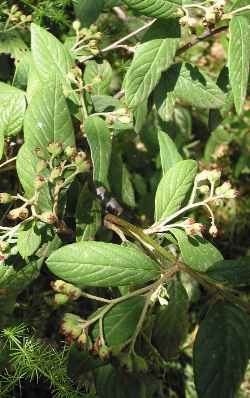
Sunset®: 3-24,31-34,39
AHS: 7-5
USDA: 6-10
Sun Exposure: Full sun or partial shade
Origin: Western China
Growth Habits: Deciduous shrub (semi-evergreen in warm winter areas), up to 12 feet tall (3.60 m), 10 feet spread (3 m); alternate, willow-like, dark green, wrinkled leaves, 1.6-3.6 inches long (4-9 cm), 0.32-0.8 inch wide (0.8-2.0 cm), pubescent, glaucous underside, foliage turns bronze to purplish red in fall and winter
Watering Needs: Moderate water in Phoenix, prefers moist, well drained, slightly acid soil
Propagation: Seeds (need stratification), semi-ripe cuttings in summer, the root system is fragile and transplanting can be a problem
Cultivars:
- 'Gnom': 8 to 12 inches tall (20-30 cm)
- 'Herbstfeuer', 'Autumn Fire': 1 to 2 feet tall (30-60 cm), evergreen leaves
- 'Moner', 'Emerald Carpet': 1 foot tall (30 cm), 6 to 8 feet spread (1.8-2.4 m), dense foliage.
- 'Repens' ('Repandens'): up to 2 feet tall (60 cm), 8 feet wide (2.4 m). Bright red berries in the fall. Evergreen in warmer areas.
- 'Scarlet Leader' - dense, prostrate plant with arching branches. Bronze foliage and small red fruit in the fall.
Blooming Habits:
Small white flowers in spring, in woolly flat-topped clusters, 2 inches wide (5 cm). The smell of the flowers is faintly unpleasant. The flowers are followed by showy red fruits persisting in winter.
Desert-Tropicals is dedicated to provide gardening advice, gardening ideas, and information about flower of all kind for landscape and collections.We try to check carefully the identification of the plants on the illustrations as well as the other information from the page, but occasionally errors do occur. if you notice anything that needs to be changed please contact us.Thanks.
© 1998-2020 Philippe Faucon, All Rights Reserved.